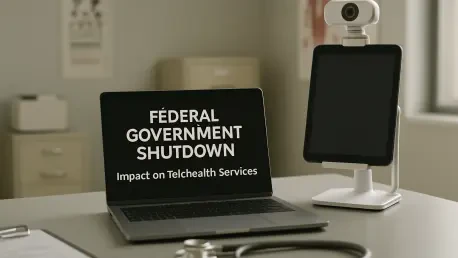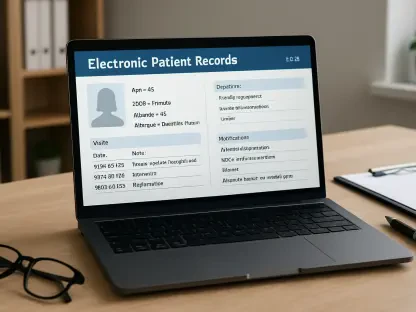As the federal government shutdown stretches into its third day on October 3, the ripple effects are being felt across various sectors, with healthcare—specifically telehealth services—emerging as one of the earliest and most significantly impacted areas. Telehealth, a lifeline for many during the COVID-19 pandemic, has transformed how care is delivered, particularly for Medicare beneficiaries. However, the current shutdown threatens to undo years of progress by reinstating pre-pandemic restrictions on these services. Reports indicate that without swift Congressional action, providers and patients alike face uncertainty about access and reimbursement. This situation raises critical questions about the sustainability of virtual care amidst political gridlock. The following sections delve into the immediate consequences, provider recommendations, historical context, and temporary measures implemented by federal agencies, shedding light on the broader implications for the healthcare landscape during this challenging period.
1. Immediate Consequences for Virtual Care
The federal shutdown has brought an abrupt halt to the expanded telehealth provisions that were a hallmark of the response to the COVID-19 crisis, creating significant hurdles for both providers and patients. As of October 1, statutory limitations on Medicare telehealth services, which had been relaxed during the public health emergency, have been reinstated for non-behavioral and non-mental health services. According to official communications, these restrictions prohibit many services from being delivered to beneficiaries in their homes or outside rural areas. Additionally, hospice recertifications requiring face-to-face encounters are affected, potentially disrupting eligibility for other Medicare benefits. The sudden reimposition of these rules has caught many in the healthcare sector off guard, as the shutdown exacerbates existing challenges in delivering care to vulnerable populations who rely on remote access to medical consultations and follow-ups.
Providers now face a cloud of uncertainty regarding reimbursement for telehealth services rendered during the shutdown, leading to operational and financial dilemmas. Many are hesitant to submit claims, fearing non-payment or the need for extensive reprocessing if policies shift retroactively. Some have opted to delay billing until there is clarity from Congress, a decision that could strain cash flow for smaller practices already operating on thin margins. This hesitation reflects a broader concern about the viability of telehealth as a sustainable care model under current fiscal and political constraints. The immediate impact is clear: patients in urban settings or those unable to travel may lose access to critical services, while providers grapple with the risk of delivering care without guaranteed compensation. The situation underscores the fragility of telehealth’s integration into mainstream healthcare when federal support is disrupted.
2. Guidance for Healthcare Providers
Amid the uncertainty caused by the federal shutdown, specific recommendations have been issued to help providers navigate the complex landscape of telehealth reimbursement and compliance. Official guidance suggests that practitioners offering telehealth services not currently payable by Medicare should consider issuing an Advance Beneficiary Notice of Noncoverage to patients. This notice informs beneficiaries that they may be responsible for the cost of services if Medicare does not cover them, protecting providers from potential financial losses. This step is particularly crucial for non-behavioral and non-mental health services now subject to pre-COVID restrictions. By taking this precaution, providers can maintain transparency with patients while mitigating the risk of unpaid claims piling up during the ongoing political impasse over federal funding.
Furthermore, healthcare professionals are strongly encouraged to closely monitor Congressional developments for any updates or legislative actions that could reverse the current restrictions. Holding claims for telehealth services not covered under Medicare until a resolution is reached is another advised strategy. This approach minimizes the administrative burden of reprocessing claims if retroactive coverage is granted. Such guidance highlights the need for agility in adapting to rapidly changing federal policies. Providers must balance the immediate needs of patients with the financial realities of operating under uncertain reimbursement conditions. Staying informed and prepared for potential shifts in policy will be key to sustaining telehealth services through this period of federal disruption, ensuring that patient care remains a priority despite bureaucratic challenges.
3. Historical Growth of Remote Healthcare
The trajectory of telehealth adoption provides critical context for understanding the stakes of the current federal shutdown. During the peak of the COVID-19 pandemic, usage among Medicare fee-for-service beneficiaries surged by an astonishing 63-fold, as reported by the U.S. Department of Health and Human Services. This dramatic increase reflected the urgent need for safe, accessible care when in-person visits posed significant risks. Telehealth became a cornerstone of healthcare delivery, bridging gaps for patients in rural and urban settings alike. The technology enabled consultations, follow-ups, and even chronic disease management from the safety of one’s home, fundamentally altering perceptions of how medical services could be provided effectively without traditional office visits.
More recent data underscores the sustained reliance on telehealth as a vital component of the healthcare system. Last year, an impressive 95 percent of health centers funded by the Health Resources and Services Administration utilized telehealth to deliver at least some primary care services. Additionally, a quarter of Medicare users accessed at least one telehealth service during the same period, illustrating widespread acceptance among beneficiaries. This integration into routine care highlights why the current restrictions imposed by the shutdown are so disruptive. The rollback of expanded access threatens to undo significant progress, particularly for those who have come to depend on virtual care for managing ongoing health conditions. The historical growth of telehealth serves as a reminder of its proven value and the potential consequences of scaling back support at a critical juncture.
4. Federal Response and Interim Solutions
In response to the federal shutdown, the Centers for Medicare & Medicaid Services (CMS) has implemented temporary measures to manage the impact on telehealth and other healthcare services. A key action includes directing Medicare Administrative Contractors to place a temporary hold on claims, a standard practice expected to last up to 10 business days. This hold ensures that payments align with statutory requirements and avoids the need for reprocessing large volumes of claims should Congress act after the deadline. CMS emphasizes that this measure has minimal impact on providers due to the existing 14-day payment floor, allowing claims to be submitted during the hold, though payments will be delayed until the hold is lifted. This interim solution aims to maintain order in the claims process amidst legislative uncertainty.
Additionally, CMS has clarified provisions for certain Accountable Care Organizations (ACOs) under the Bipartisan Budget Act of 2018, offering a lifeline for some telehealth services. Clinicians in applicable Medicare Shared Savings Program ACOs can provide and bill for covered telehealth services to beneficiaries without geographic restrictions or limitations on home settings, regardless of Congressional inaction. No special application or approval process is required for these ACO participants, providing a degree of stability for a subset of providers and patients. This exception highlights a potential pathway for maintaining access to virtual care during the shutdown, though it does not cover all providers or services. These federal responses, while limited, demonstrate an effort to mitigate disruption while broader legislative solutions remain pending.
5. Navigating the Path Forward
Reflecting on the federal shutdown’s impact, it becomes evident that telehealth services, once a beacon of innovation during the COVID-19 crisis, stand at a vulnerable crossroads. The reinstatement of restrictive pre-pandemic policies has already begun to limit access for many patients, particularly those in urban areas or requiring home-based care. Providers face tough decisions about continuing virtual services without guaranteed reimbursement, a challenge that tests the resilience of healthcare systems nationwide. The historical surge in telehealth adoption underscores what is at stake, as millions have come to rely on these services for essential medical support over recent years.
Looking ahead, the resolution of this crisis hinges on swift Congressional intervention to restore expanded telehealth provisions and ensure retroactive coverage for claims submitted during the shutdown. Stakeholders are urged to advocate for legislative clarity while exploring alternative funding or partnerships to sustain virtual care in the interim. Providers need to maintain open communication with patients about potential costs and coverage gaps. As the situation evolves, staying proactive by tracking policy updates and preparing for various outcomes emerges as a critical step to safeguard access to telehealth, ensuring that the progress made in healthcare delivery is not lost to temporary political gridlock.









